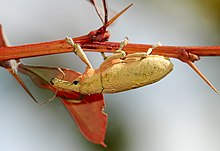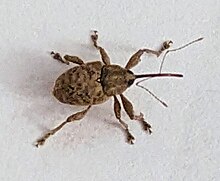Weevil
| Weevils Temporal range:
| |
|---|---|

| |
| Lixus pulverulentus | |
| Scientific classification | |
| Domain: | Eukaryota |
| Kingdom: | Animalia |
| Phylum: | Arthropoda |
| Class: | Insecta |
| Order: | Coleoptera |
| Suborder: | Polyphaga |
| Infraorder: | Cucujiformia |
| Clade: | Phytophaga |
| Superfamily: | Curculionoidea Latreille, 1802 |
| Families | |
| |
Weevils are
Many weevils are considered pests because of their ability to damage and kill crops. The grain or wheat weevil (Sitophilus granarius) damages stored grain, as does the maize weevil (Sitophilus zeamais) among others. The boll weevil (Anthonomus grandis) attacks cotton crops; it lays its eggs inside cotton bolls and the larvae eat their way out. Other weevils are used for biological control of invasive plants.
A weevil's rostrum, or elongated snout, hosts chewing mouthparts instead of the piercing mouthparts that proboscis-possessing insects are known for. The mouthparts are often used to excavate tunnels into grains.[1] In more derived weevils, the rostrum has a groove in which the weevil can fold the first segment of its antennae.
Most weevils have the ability to fly (including pest species such as the rice weevil[2][3]), though a significant number are flightless, such as the genus Otiorhynchus.
One species of weevil, Austroplatypus incompertus, exhibits eusociality, one of the few insects outside the Hymenoptera and the Isoptera to do so.

Taxonomy and phylogeny
Because so many species exist in such diversity, the higher classification of weevils is in a state of flux. They are generally divided into two major divisions, the Orthoceri or primitive weevils, and the Gonatoceri or true weevils (
A 1995 classification system to family level was provided by Kuschel,
The interfamilial relationships of Curculionoidea have been generally well resolved.
| |||||||
Families
- Anthribidae—fungus weevils
- Attelabidae—leaf rolling weevils
- Belidae—primitive weevils
- Brentidae—straight snout weevils
- Caridae
- Cimberididae
- Curculionidae—true weevils
- †Mesophyletidae
- Nemonychidae—pine flower weevils
- †?Obrieniidae
Sexual dimorphism
Rhopalapion longirostre exhibits an extreme case of sexual dimorphism. The female rostrum is twice as long and its surface is smoother than in the male. The female bores egg channels into the buds of Alcea rosea. Thus, the dimorphism is not attributed to sexual selection. It is a response to ecological demands of egg deposition.[15]
Another example of extreme dimorphism in weevils is that of the New Zealand giraffe weevil, males measure up to 90 mm (3.5 in), and females 50 mm (2.0 in), although there is an extreme range of body sizes in both sexes.
References
- S2CID 82634306.
- ^ "What Is a Weevil and How Did That Bug Get in My Food?".
- ^ "Weevils on Stored Grain (Department of Entomology)". Department of Entomology (Penn State University).
- CSIRO. pp. 741 pp.
- Memoirs of the Entomological Society of Washington. 14: 5–33.
- ^ PMID 12396590.
- ^ PMID 29294021.
- .
- S2CID 248303405.
- ^ Legalov, A. A. (2010). "Checklist of Mesozoic Curculionoidea (Coleoptera) with description of new taxa". Baltic Journal of Coleopterology. 10 (1): 71–101.
- .
- hdl:11336/152180.
- S2CID 84345520.
- ^ PMID 37727076.
- .
Further reading
- Bright, Donald E.; Bouchard, Patrice (2008). Coleoptera, Curculionidae, Entiminae: Weevils of Canada and Alaska Volume 2. Insects and Arachnids of Canada Series, Part 25. Ottawa: NRC Research Press. ISBN 978-0-660-19400-4.
External links
 Media related to Curculionoidea at Wikimedia Commons
Media related to Curculionoidea at Wikimedia Commons
